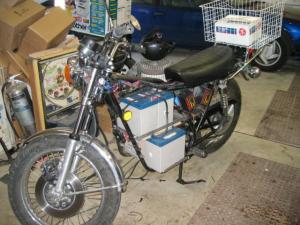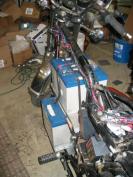| Owner | Bob Tregilus | ||||||
|---|---|---|---|---|---|---|---|
| Location | Reno, Nevada United States map | ||||||
| Web/Email | WebPage | ||||||
| Vehicle | 1976 Kawasaki KZ400 | ||||||
| Motor | Briggs and Stratton Etek Permanent Magnet DC Went through a set of brushes in 2000 miles! I think I'm using too big of a controller at 400 amps. The motor is rated at 325 amps. 3/7/07 - Cranked the controller down to 275 amps. I'm told that will solve the brush problem. | ||||||
| Drivetrain | Number 40 chain drive, 14 x 72. | ||||||
| Controller | Alltrax AXE-4844 Fried the first controller after 2000 miles. Fried a second one after 600 more miles. Haven't figured out what's wrong yet!? 3/7/07 - It looks like having a common ground to the chassis on the 48 VDC series battery pack is the problem. The ground was unfused as well. I've corrected it by adding a 10 amp DC/DC converter to power lighting and eliminating any ground(s) to the chassis. Formally, I was powering the lighting off one of the four batteries in the series pack, hence the chassis ground. Additionally, I added a contactor. | ||||||
| Batteries | 4 Power Sonic PG-12V55, 12.00 Volt, Lead-Acid, AGM Rated 55 AH batteries. Forty-two pounds each. The lead has since died and replacement costs have more than doubled so I was able to find four 90ah Saft NiMHs on the gray market and am currently adapting them to the bike. | ||||||
| System Voltage | 48 Volts | ||||||
| Charger | Chargetech CT-500-1 I'm using two of these chargers. Each has two isolated outputs. Charges in about eight hours with 50% depleted batteries. | ||||||
| Heater | Are you kidding? | ||||||
| DC/DC Converter | Unknown 48vdc-12vdc 10amp | ||||||
| Instrumentation | Speedometer and battery fuel gauge | ||||||
| Top Speed | 50 MPH (80 KPH) Runs well at all speeds. Climbs hills easily. | ||||||
| Acceleration | Pretty good acceleration, but then I'm no motorcyclist! I just did this to save money. | ||||||
| Range | 12 Miles (19 Kilometers) I get ten to twelve miles depending on speed and hills. I never let the batteries fall below 50 percent. | ||||||
| EV Miles |
| ||||||
| Seating Capacity | Two | ||||||
| Curb Weight | 470 Pounds (213 Kilograms) Stock bike wet was 399 lbs. | ||||||
| Tires | Standard rib: front 3.25x18; rear 3.50x18. | ||||||
| Conversion Time | About six months. | ||||||
| Conversion Cost | About $1,500. | ||||||
| I decided to build the motorcycle in the summer of '05 when gas prices were soaring. Animated by the need to save money, and the disgust of paying exorbitant taxes for gasoline, I went shopping for a Vespa scooter. While en-route to the Vespa store, however, I stopped by an Arco station and was greeted by an "Out of Gas" sign. I instantly had flashbacks to '70s style gas lines and I became a very motivated Vespa buyer. I looked at the Vespas and returned home to do further research. Phoning a friend, now in Oregon and who formally owned a motorcycle shop in Northern California, he convinced me that scooters require a lot of maintenance and that I should go ahead and build an electric motorcycle. He had converted a Honda Trail 90 (CT-90) several years ago and always had had an interest in DC powered equipment and appliances. Being a shade-tree mechanic with a lot of equipment and fabricating experience, coupled with my friend's advice and previous experience with building an electric motorcycle, I felt it would be a rather simple project. I was wrong. As Henry David Thoreau reminds us: "[G]overnment never of itself furthered any enterprise, but by the alacrity with which it got out of its way." The laws governing the storage, resale, and registration of motorcycles in this state are utterly unenlightened and clearly designed to benefit the state through the permitting process as well as dealers by forcing the purchase new equipment. Motorcycle junkyards are in essence illegal in Nevada! I spent several months trying to understand the Nevada Revised Statutes and speaking with DMV employees, who, like the IRS, gave me different answers to the same questions on multiple occasions. Once I felt I had a rudimentary understanding of the laws I started shopping for a "rolling chassis" (a bike without an engine but good wheels, lights, & c.) in either a dual-sport or road bike. Being a political activist I'm fairly well connected so I utilized my network to find a viable candidate for the conversion project. One primary criteria was it had to be a mid-weight bike with dual down-tubes to cradle the battery pack. My friend told me of several models I should be looking for, most in the dual-sport class. He is biased a bit being an ex-motocross racer. My "network" responded with a few leads and I was finally able to uncover several "underground" motorcycle junkyards. These were motorcycle collections maintained by enthusiasts much to the chagrin of the Nevada State Legislature and the sheriff's office if they only knew. The classic Yamaha DT-1 dual-sport was of initial interest and I found several. Also, I saw quite a few Kawasaki KZ400s, a classic road bike that was the commuter's answer to the gas crunch of the '70s. As I found more and more candidate bikes for the conversion project it became more and more evident that Nevada laws were getting in my way of making a purchase. Old junk motorcycles may come in many flavors but share one thing in common - the titles are lost. And it's nearly impossible to re-register a junk motorcycle in Nevada. First, the laws are designed to make it illegal to possess unregistered vehicles. Secondly, re-registering a vehicle with a lost title is so complex and potentially expensive as to render the process an exercise in futility. So, I contacted the ex-motorcycle shop owner I knew in Oregon and asked him if he had any ideas. It turned out there was a motorcycle junkyard just down the road from the small town he lives in along the Rogue River. In fact, there is a plethora of junkyards in and around the Medford area. Having pretty much decided on the KZ400, do to its boxy frame design for the engine which would work nicely for a battery box, I headed to Oregon to visit my friend. The junkyard near his house had several KZ400s that were in reasonable shape for the conversion. I purchased one - with title - and headed home with my new project bike. The first thing I did was to establish that it would pass muster with the Nevada DMV before I sank any labor into the conversion. Fortunately, I was informed, the 1976 Kawasaki KZ400 was just old enough to be exempt from anything more than a simple vehicle identification number (VIN) inspection. Given the bike had no engine and some safety features such as turn indicators were missing, I would not have been able to register it had it been only a slightly newer model. Also, of interest, had I been converting a car to electric I would not be allowed to do it without first being a state licensed electric vehicle mechanic. Finally, with my new license plate and registration in hand I headed home to start on the easy part of the project - the conversion. The first step was to mount the motor. I used an Etek motor which was Briggs and Stratton's short lived, but extremely successful (from the consumer's point of view) flirtation with electric motors. The Etek was a knockoff of the British pancake designed LEMCO permanent magnet motor. The British version, a bit more efficient and made of superior materials retails for around $1,600. The Etek was selling for about $500 when I bought it but has risen considerably in price given they are no longer in production. The Etek, however, remains a great motor. It handles up to 48 VDC and is capable of producing 15 horsepower peak and 8 horsepower continuous yet weighs only 22 pounds. The LEMCO rare-earth magnet design is highly efficient sending up to 88% of the power to the wheel instead of radiating it off in heat. Mounting the Etek went smoothly. I used a simple stainless steel plate, vertically mounted, and secured to the bike using two threaded rods (all-thread) in pre-existing engine mount holes on the frame. The bottom of the motor mounting plate is fasten to the bottom battery tray with extruded aluminum angle. The battery mounting is achieved using two pieces of aluminum sheet metal formed into trays and clamped to the frame with insulated one inch tubing clamps. The batteries are stacked, two on top and two below, four batteries total. The motor is controlled by an Altrax 48 VDC, 400 amp (adjusted down to 300 amps), golf cart controller which is mounted in the area under the seat that was previously the home for the air-box and air-filter. On the outside (opposite side of the aluminum plate supporting the controller) are fasten two 12 VDC, 2.5 amp battery chargers. Each contains two isolated chargers which allows me to charge the four batteries. Additionally, I changed all of the lighting to LEDs with the exception of the headlight which is a halogen sealed beam. The batteries are wired in series supplying a total of 48 VDC to the motor. The gearing is a simple direct drive (unlike engines, motors provide as much torque at zero RPM as they do at full RPM). I reduced the chain and gear size to save weight. After shopping for a few replacement suspension parts on eBay, where I found many given the KZ400 was a prolific bike, I completed the project by early Spring '06. I have over two thousand miles on it and currently use the bike to commute to work, school, parent's house, ladyfriend's house, and various stores. I rarely drive my truck anymore. Notes: The bike is geared for a top speed of fifty miles per hour. It accelerates and climbs hills well, probably as well as when it had an engine. I figure it weighs about 20 to 40 pounds more than a stock bike. I have a range of about twelve miles which takes the batteries down to about 50% charge. Going lower than that will decrease battery life, but clearly, I can go further than twelve miles if need be. By maintaining the batteries above 50% charge they should last over two years with daily use. It takes about six hours to recharge the batteries when they are down 50%. In a typical day, however, I usually go further than twelve miles and I have gone as far as thirty miles. If I am able, I plug it in wherever I go, work, parent's house, even Wal-Mart and Winco. The University of Nevada, Reno, is unenlightened and has no external outlets except at the grounds maintenance building. Charging the bike up from 50% depleted batteries cost an estimated 16 to 18 cents. My friend Chuck and I started an EV club in northern Nevada. The Alternative Transportation Club (ATC) & Electric Auto Association of Northern Nevada holds regular meetings in Reno. For more information please visit WebPage or call me (Bob) 755 826-4514 | |||||||
Copyright © 1997-2025 by Mike Chancey




